Business and Business Environment Analysis Report - HNC Business
VerifiedAdded on 2022/12/17
|13
|3260
|1
Report
AI Summary
This report provides a comprehensive analysis of the business and business environment, focusing on three organizations: Tesco, BBC, and Oxfam. It begins with an introduction to business environment analysis and the importance of internal and external factors. The main body of the report delves into the different types and purposes of organizations, exploring private, public, and voluntary sectors, along with their legal structures. It then examines the size and scope of these organizations, providing background information and discussing their products/services, scope, size, mission, vision, and stakeholders. The report also explores the interrelationship between different organizational functions and how they connect to the organizational structure and objectives. Furthermore, it identifies the positive and negative impacts of the macro environment (political, economic, social, and technological factors) on business operations, supported by examples. A SWOT analysis for each organization is presented, and the interrelation between strengths/weaknesses and external macro factors is explained. The report concludes with a summary of the key findings and a list of references.
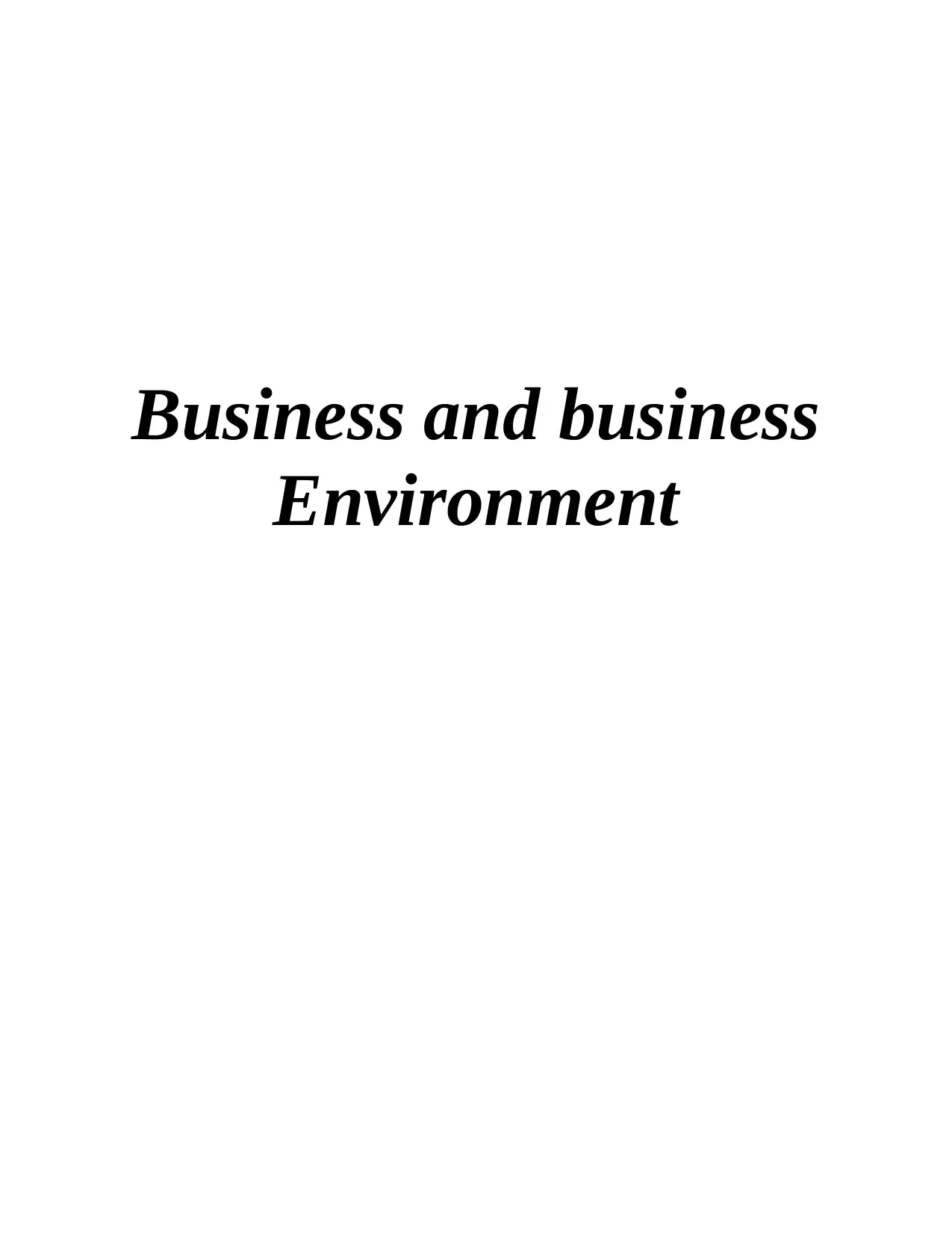
Business and business
Environment
Environment
Paraphrase This Document
Need a fresh take? Get an instant paraphrase of this document with our AI Paraphraser
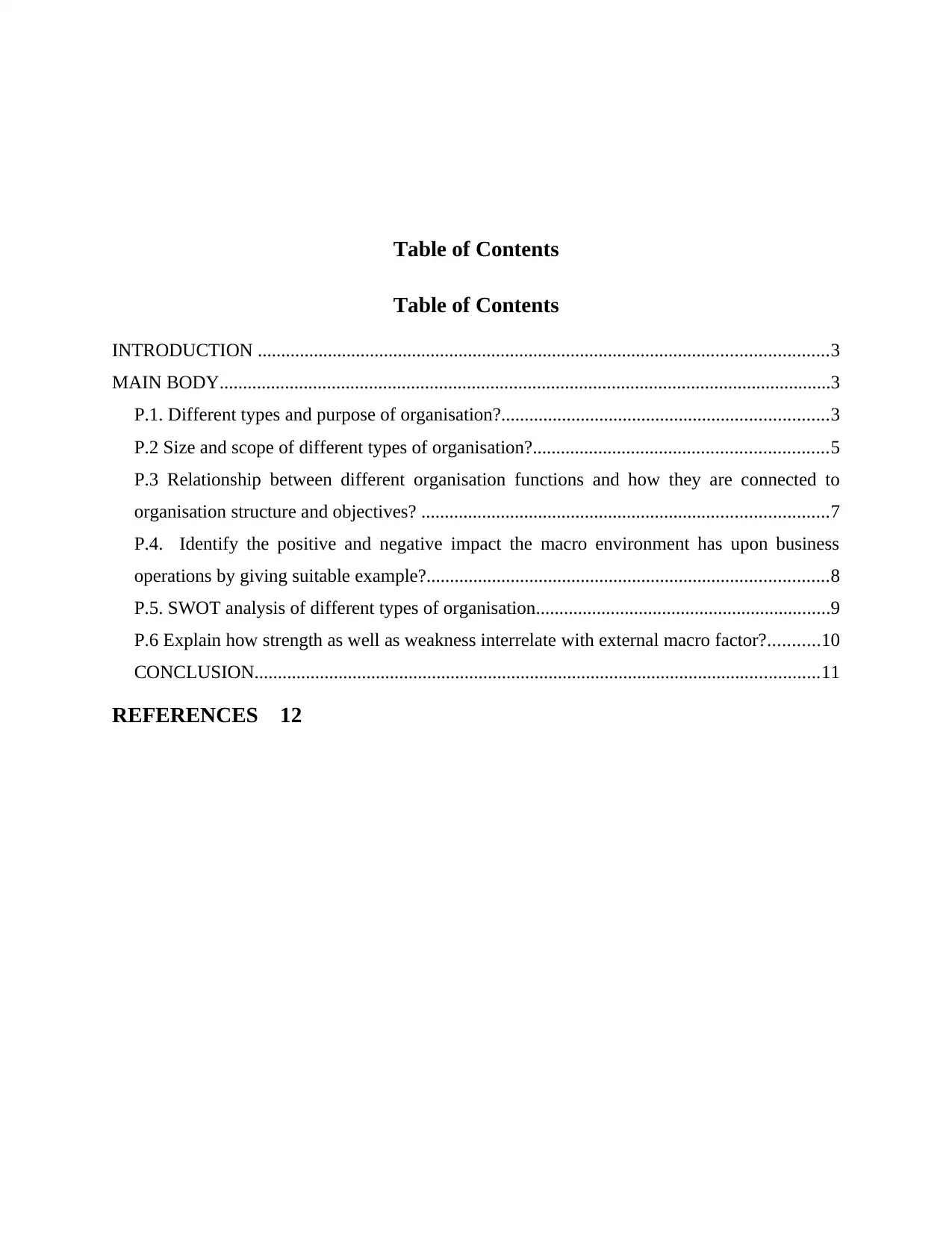
Table of Contents
Table of Contents
INTRODUCTION ..........................................................................................................................3
MAIN BODY...................................................................................................................................3
P.1. Different types and purpose of organisation?......................................................................3
P.2 Size and scope of different types of organisation?...............................................................5
P.3 Relationship between different organisation functions and how they are connected to
organisation structure and objectives? .......................................................................................7
P.4. Identify the positive and negative impact the macro environment has upon business
operations by giving suitable example?......................................................................................8
P.5. SWOT analysis of different types of organisation...............................................................9
P.6 Explain how strength as well as weakness interrelate with external macro factor?...........10
CONCLUSION.........................................................................................................................11
REFERENCES 12
Table of Contents
INTRODUCTION ..........................................................................................................................3
MAIN BODY...................................................................................................................................3
P.1. Different types and purpose of organisation?......................................................................3
P.2 Size and scope of different types of organisation?...............................................................5
P.3 Relationship between different organisation functions and how they are connected to
organisation structure and objectives? .......................................................................................7
P.4. Identify the positive and negative impact the macro environment has upon business
operations by giving suitable example?......................................................................................8
P.5. SWOT analysis of different types of organisation...............................................................9
P.6 Explain how strength as well as weakness interrelate with external macro factor?...........10
CONCLUSION.........................................................................................................................11
REFERENCES 12
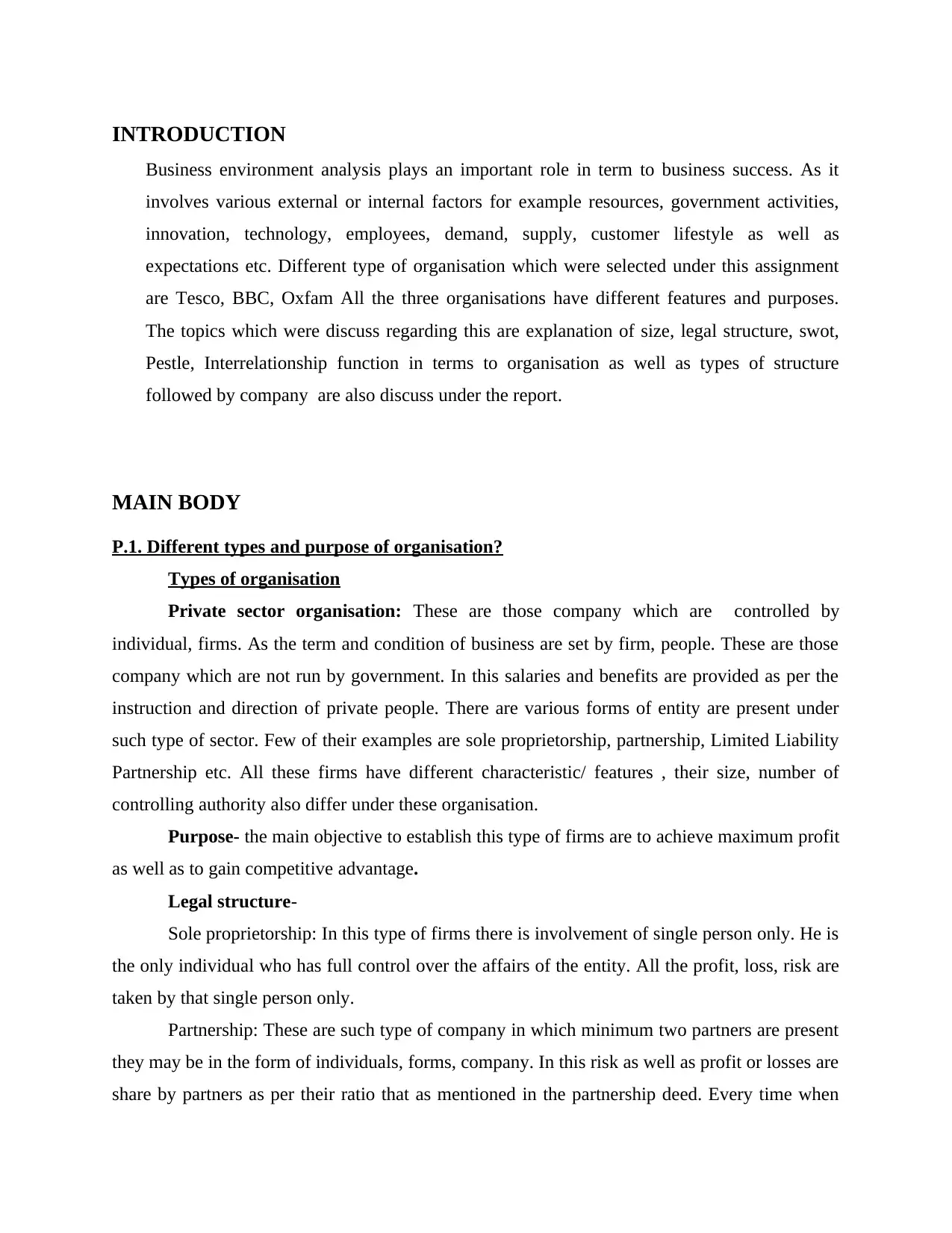
INTRODUCTION
Business environment analysis plays an important role in term to business success. As it
involves various external or internal factors for example resources, government activities,
innovation, technology, employees, demand, supply, customer lifestyle as well as
expectations etc. Different type of organisation which were selected under this assignment
are Tesco, BBC, Oxfam All the three organisations have different features and purposes.
The topics which were discuss regarding this are explanation of size, legal structure, swot,
Pestle, Interrelationship function in terms to organisation as well as types of structure
followed by company are also discuss under the report.
MAIN BODY
P.1. Different types and purpose of organisation?
Types of organisation
Private sector organisation: These are those company which are controlled by
individual, firms. As the term and condition of business are set by firm, people. These are those
company which are not run by government. In this salaries and benefits are provided as per the
instruction and direction of private people. There are various forms of entity are present under
such type of sector. Few of their examples are sole proprietorship, partnership, Limited Liability
Partnership etc. All these firms have different characteristic/ features , their size, number of
controlling authority also differ under these organisation.
Purpose- the main objective to establish this type of firms are to achieve maximum profit
as well as to gain competitive advantage.
Legal structure-
Sole proprietorship: In this type of firms there is involvement of single person only. He is
the only individual who has full control over the affairs of the entity. All the profit, loss, risk are
taken by that single person only.
Partnership: These are such type of company in which minimum two partners are present
they may be in the form of individuals, forms, company. In this risk as well as profit or losses are
share by partners as per their ratio that as mentioned in the partnership deed. Every time when
Business environment analysis plays an important role in term to business success. As it
involves various external or internal factors for example resources, government activities,
innovation, technology, employees, demand, supply, customer lifestyle as well as
expectations etc. Different type of organisation which were selected under this assignment
are Tesco, BBC, Oxfam All the three organisations have different features and purposes.
The topics which were discuss regarding this are explanation of size, legal structure, swot,
Pestle, Interrelationship function in terms to organisation as well as types of structure
followed by company are also discuss under the report.
MAIN BODY
P.1. Different types and purpose of organisation?
Types of organisation
Private sector organisation: These are those company which are controlled by
individual, firms. As the term and condition of business are set by firm, people. These are those
company which are not run by government. In this salaries and benefits are provided as per the
instruction and direction of private people. There are various forms of entity are present under
such type of sector. Few of their examples are sole proprietorship, partnership, Limited Liability
Partnership etc. All these firms have different characteristic/ features , their size, number of
controlling authority also differ under these organisation.
Purpose- the main objective to establish this type of firms are to achieve maximum profit
as well as to gain competitive advantage.
Legal structure-
Sole proprietorship: In this type of firms there is involvement of single person only. He is
the only individual who has full control over the affairs of the entity. All the profit, loss, risk are
taken by that single person only.
Partnership: These are such type of company in which minimum two partners are present
they may be in the form of individuals, forms, company. In this risk as well as profit or losses are
share by partners as per their ratio that as mentioned in the partnership deed. Every time when
⊘ This is a preview!⊘
Do you want full access?
Subscribe today to unlock all pages.

Trusted by 1+ million students worldwide
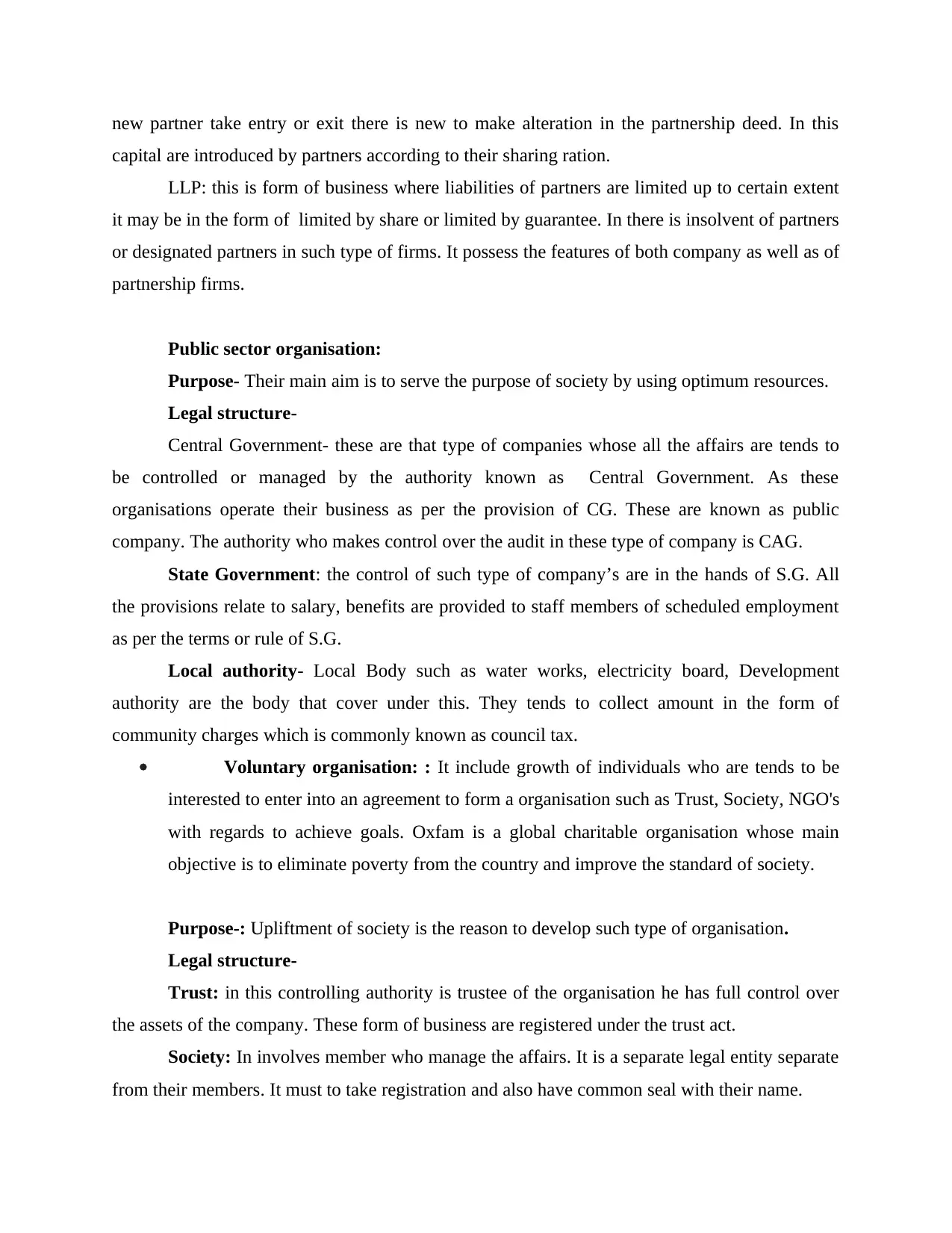
new partner take entry or exit there is new to make alteration in the partnership deed. In this
capital are introduced by partners according to their sharing ration.
LLP: this is form of business where liabilities of partners are limited up to certain extent
it may be in the form of limited by share or limited by guarantee. In there is insolvent of partners
or designated partners in such type of firms. It possess the features of both company as well as of
partnership firms.
Public sector organisation:
Purpose- Their main aim is to serve the purpose of society by using optimum resources.
Legal structure-
Central Government- these are that type of companies whose all the affairs are tends to
be controlled or managed by the authority known as Central Government. As these
organisations operate their business as per the provision of CG. These are known as public
company. The authority who makes control over the audit in these type of company is CAG.
State Government: the control of such type of company’s are in the hands of S.G. All
the provisions relate to salary, benefits are provided to staff members of scheduled employment
as per the terms or rule of S.G.
Local authority- Local Body such as water works, electricity board, Development
authority are the body that cover under this. They tends to collect amount in the form of
community charges which is commonly known as council tax.
Voluntary organisation: : It include growth of individuals who are tends to be
interested to enter into an agreement to form a organisation such as Trust, Society, NGO's
with regards to achieve goals. Oxfam is a global charitable organisation whose main
objective is to eliminate poverty from the country and improve the standard of society.
Purpose-: Upliftment of society is the reason to develop such type of organisation.
Legal structure-
Trust: in this controlling authority is trustee of the organisation he has full control over
the assets of the company. These form of business are registered under the trust act.
Society: In involves member who manage the affairs. It is a separate legal entity separate
from their members. It must to take registration and also have common seal with their name.
capital are introduced by partners according to their sharing ration.
LLP: this is form of business where liabilities of partners are limited up to certain extent
it may be in the form of limited by share or limited by guarantee. In there is insolvent of partners
or designated partners in such type of firms. It possess the features of both company as well as of
partnership firms.
Public sector organisation:
Purpose- Their main aim is to serve the purpose of society by using optimum resources.
Legal structure-
Central Government- these are that type of companies whose all the affairs are tends to
be controlled or managed by the authority known as Central Government. As these
organisations operate their business as per the provision of CG. These are known as public
company. The authority who makes control over the audit in these type of company is CAG.
State Government: the control of such type of company’s are in the hands of S.G. All
the provisions relate to salary, benefits are provided to staff members of scheduled employment
as per the terms or rule of S.G.
Local authority- Local Body such as water works, electricity board, Development
authority are the body that cover under this. They tends to collect amount in the form of
community charges which is commonly known as council tax.
Voluntary organisation: : It include growth of individuals who are tends to be
interested to enter into an agreement to form a organisation such as Trust, Society, NGO's
with regards to achieve goals. Oxfam is a global charitable organisation whose main
objective is to eliminate poverty from the country and improve the standard of society.
Purpose-: Upliftment of society is the reason to develop such type of organisation.
Legal structure-
Trust: in this controlling authority is trustee of the organisation he has full control over
the assets of the company. These form of business are registered under the trust act.
Society: In involves member who manage the affairs. It is a separate legal entity separate
from their members. It must to take registration and also have common seal with their name.
Paraphrase This Document
Need a fresh take? Get an instant paraphrase of this document with our AI Paraphraser
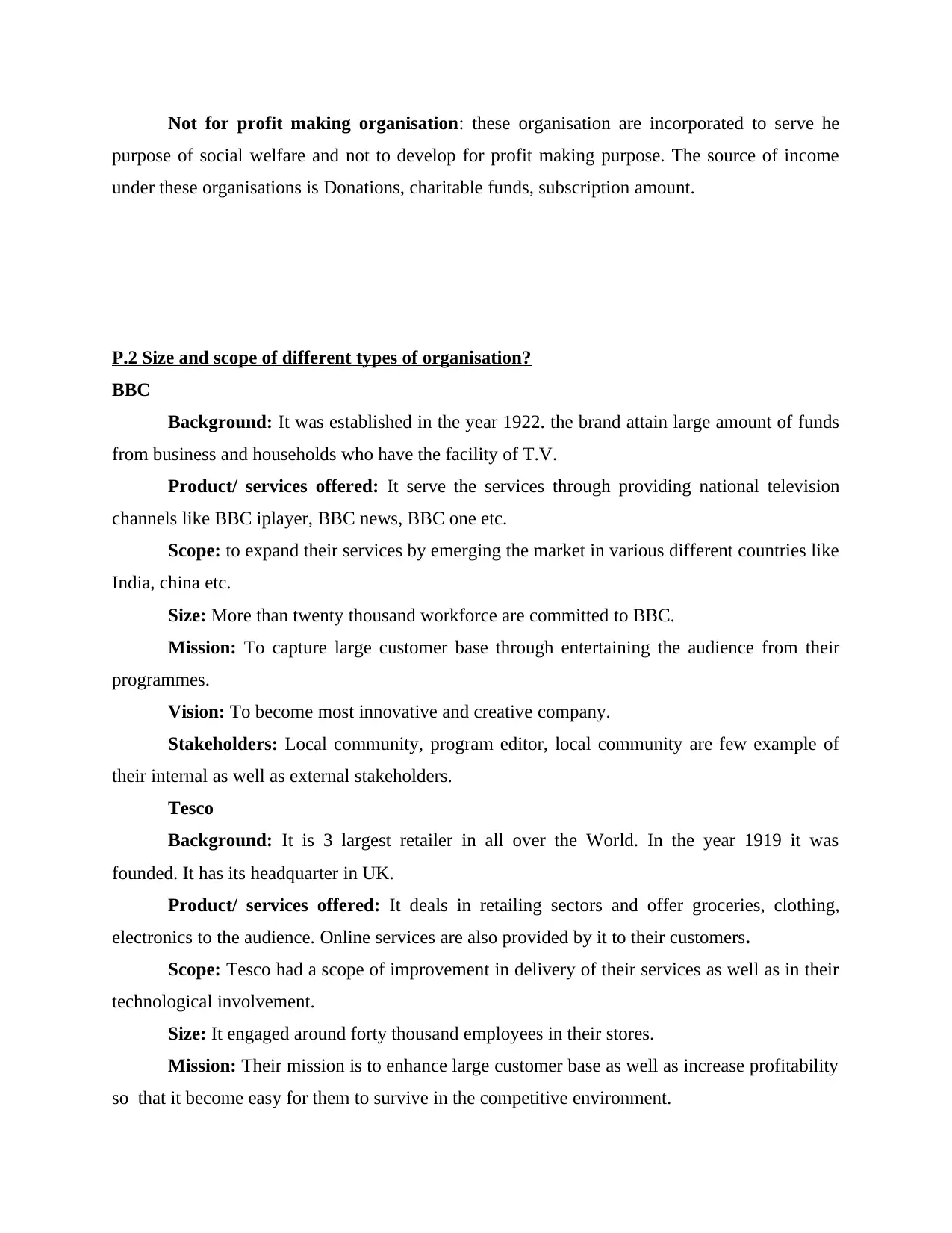
Not for profit making organisation: these organisation are incorporated to serve he
purpose of social welfare and not to develop for profit making purpose. The source of income
under these organisations is Donations, charitable funds, subscription amount.
P.2 Size and scope of different types of organisation?
BBC
Background: It was established in the year 1922. the brand attain large amount of funds
from business and households who have the facility of T.V.
Product/ services offered: It serve the services through providing national television
channels like BBC iplayer, BBC news, BBC one etc.
Scope: to expand their services by emerging the market in various different countries like
India, china etc.
Size: More than twenty thousand workforce are committed to BBC.
Mission: To capture large customer base through entertaining the audience from their
programmes.
Vision: To become most innovative and creative company.
Stakeholders: Local community, program editor, local community are few example of
their internal as well as external stakeholders.
Tesco
Background: It is 3 largest retailer in all over the World. In the year 1919 it was
founded. It has its headquarter in UK.
Product/ services offered: It deals in retailing sectors and offer groceries, clothing,
electronics to the audience. Online services are also provided by it to their customers.
Scope: Tesco had a scope of improvement in delivery of their services as well as in their
technological involvement.
Size: It engaged around forty thousand employees in their stores.
Mission: Their mission is to enhance large customer base as well as increase profitability
so that it become easy for them to survive in the competitive environment.
purpose of social welfare and not to develop for profit making purpose. The source of income
under these organisations is Donations, charitable funds, subscription amount.
P.2 Size and scope of different types of organisation?
BBC
Background: It was established in the year 1922. the brand attain large amount of funds
from business and households who have the facility of T.V.
Product/ services offered: It serve the services through providing national television
channels like BBC iplayer, BBC news, BBC one etc.
Scope: to expand their services by emerging the market in various different countries like
India, china etc.
Size: More than twenty thousand workforce are committed to BBC.
Mission: To capture large customer base through entertaining the audience from their
programmes.
Vision: To become most innovative and creative company.
Stakeholders: Local community, program editor, local community are few example of
their internal as well as external stakeholders.
Tesco
Background: It is 3 largest retailer in all over the World. In the year 1919 it was
founded. It has its headquarter in UK.
Product/ services offered: It deals in retailing sectors and offer groceries, clothing,
electronics to the audience. Online services are also provided by it to their customers.
Scope: Tesco had a scope of improvement in delivery of their services as well as in their
technological involvement.
Size: It engaged around forty thousand employees in their stores.
Mission: Their mission is to enhance large customer base as well as increase profitability
so that it become easy for them to survive in the competitive environment.
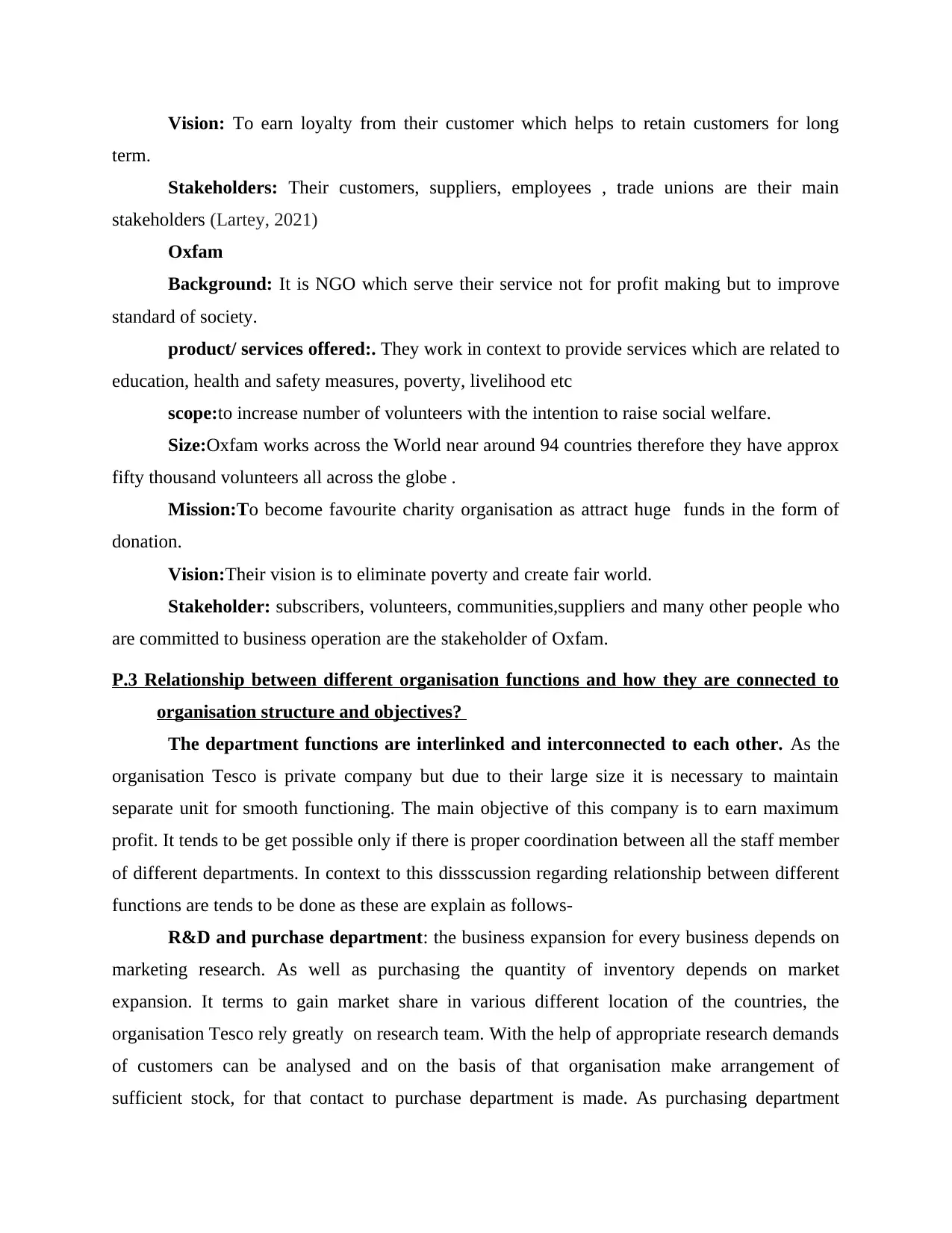
Vision: To earn loyalty from their customer which helps to retain customers for long
term.
Stakeholders: Their customers, suppliers, employees , trade unions are their main
stakeholders (Lartey, 2021)
Oxfam
Background: It is NGO which serve their service not for profit making but to improve
standard of society.
product/ services offered:. They work in context to provide services which are related to
education, health and safety measures, poverty, livelihood etc
scope:to increase number of volunteers with the intention to raise social welfare.
Size:Oxfam works across the World near around 94 countries therefore they have approx
fifty thousand volunteers all across the globe .
Mission:To become favourite charity organisation as attract huge funds in the form of
donation.
Vision:Their vision is to eliminate poverty and create fair world.
Stakeholder: subscribers, volunteers, communities,suppliers and many other people who
are committed to business operation are the stakeholder of Oxfam.
P.3 Relationship between different organisation functions and how they are connected to
organisation structure and objectives?
The department functions are interlinked and interconnected to each other. As the
organisation Tesco is private company but due to their large size it is necessary to maintain
separate unit for smooth functioning. The main objective of this company is to earn maximum
profit. It tends to be get possible only if there is proper coordination between all the staff member
of different departments. In context to this dissscussion regarding relationship between different
functions are tends to be done as these are explain as follows-
R&D and purchase department: the business expansion for every business depends on
marketing research. As well as purchasing the quantity of inventory depends on market
expansion. It terms to gain market share in various different location of the countries, the
organisation Tesco rely greatly on research team. With the help of appropriate research demands
of customers can be analysed and on the basis of that organisation make arrangement of
sufficient stock, for that contact to purchase department is made. As purchasing department
term.
Stakeholders: Their customers, suppliers, employees , trade unions are their main
stakeholders (Lartey, 2021)
Oxfam
Background: It is NGO which serve their service not for profit making but to improve
standard of society.
product/ services offered:. They work in context to provide services which are related to
education, health and safety measures, poverty, livelihood etc
scope:to increase number of volunteers with the intention to raise social welfare.
Size:Oxfam works across the World near around 94 countries therefore they have approx
fifty thousand volunteers all across the globe .
Mission:To become favourite charity organisation as attract huge funds in the form of
donation.
Vision:Their vision is to eliminate poverty and create fair world.
Stakeholder: subscribers, volunteers, communities,suppliers and many other people who
are committed to business operation are the stakeholder of Oxfam.
P.3 Relationship between different organisation functions and how they are connected to
organisation structure and objectives?
The department functions are interlinked and interconnected to each other. As the
organisation Tesco is private company but due to their large size it is necessary to maintain
separate unit for smooth functioning. The main objective of this company is to earn maximum
profit. It tends to be get possible only if there is proper coordination between all the staff member
of different departments. In context to this dissscussion regarding relationship between different
functions are tends to be done as these are explain as follows-
R&D and purchase department: the business expansion for every business depends on
marketing research. As well as purchasing the quantity of inventory depends on market
expansion. It terms to gain market share in various different location of the countries, the
organisation Tesco rely greatly on research team. With the help of appropriate research demands
of customers can be analysed and on the basis of that organisation make arrangement of
sufficient stock, for that contact to purchase department is made. As purchasing department
⊘ This is a preview!⊘
Do you want full access?
Subscribe today to unlock all pages.

Trusted by 1+ million students worldwide
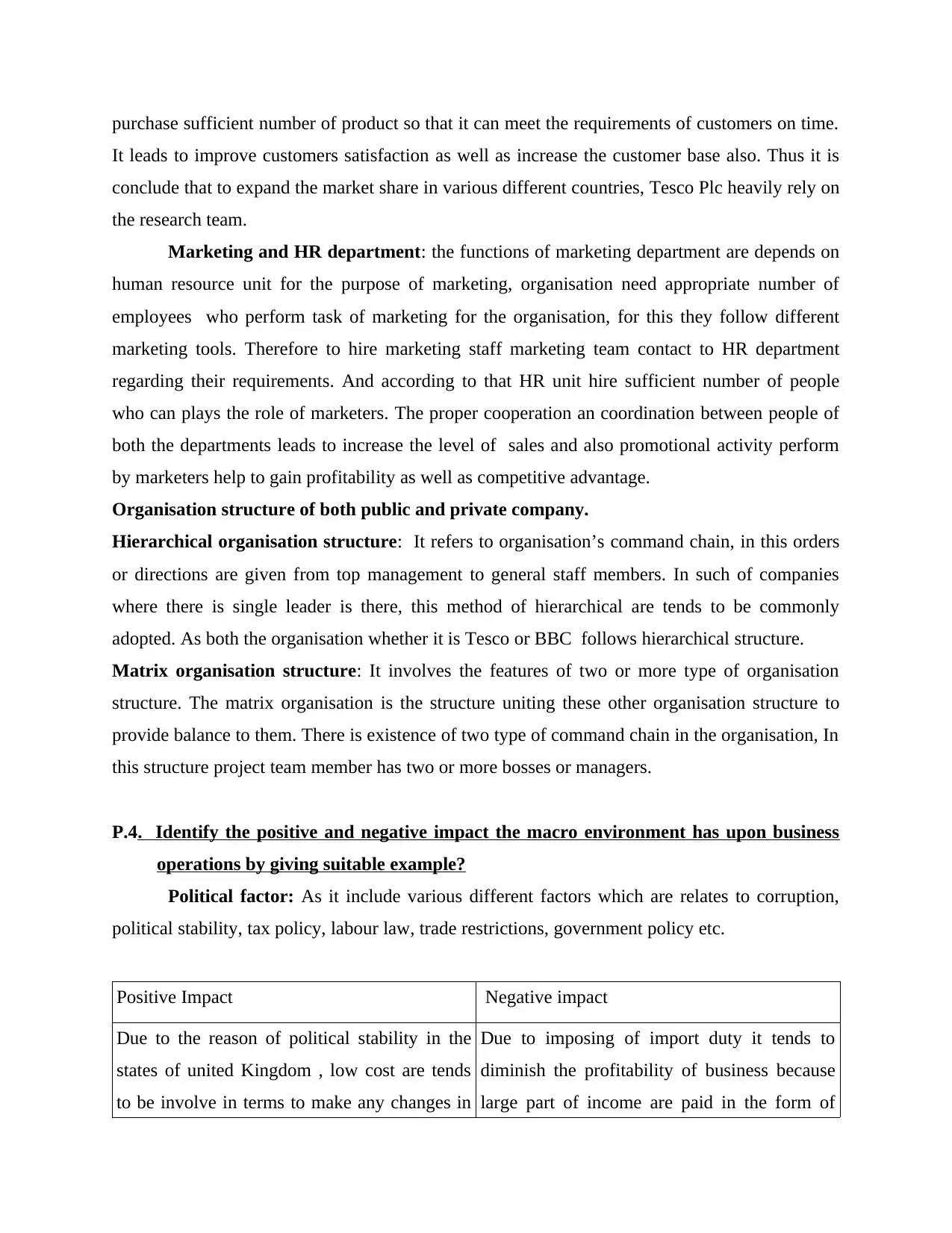
purchase sufficient number of product so that it can meet the requirements of customers on time.
It leads to improve customers satisfaction as well as increase the customer base also. Thus it is
conclude that to expand the market share in various different countries, Tesco Plc heavily rely on
the research team.
Marketing and HR department: the functions of marketing department are depends on
human resource unit for the purpose of marketing, organisation need appropriate number of
employees who perform task of marketing for the organisation, for this they follow different
marketing tools. Therefore to hire marketing staff marketing team contact to HR department
regarding their requirements. And according to that HR unit hire sufficient number of people
who can plays the role of marketers. The proper cooperation an coordination between people of
both the departments leads to increase the level of sales and also promotional activity perform
by marketers help to gain profitability as well as competitive advantage.
Organisation structure of both public and private company.
Hierarchical organisation structure: It refers to organisation’s command chain, in this orders
or directions are given from top management to general staff members. In such of companies
where there is single leader is there, this method of hierarchical are tends to be commonly
adopted. As both the organisation whether it is Tesco or BBC follows hierarchical structure.
Matrix organisation structure: It involves the features of two or more type of organisation
structure. The matrix organisation is the structure uniting these other organisation structure to
provide balance to them. There is existence of two type of command chain in the organisation, In
this structure project team member has two or more bosses or managers.
P.4. Identify the positive and negative impact the macro environment has upon business
operations by giving suitable example?
Political factor: As it include various different factors which are relates to corruption,
political stability, tax policy, labour law, trade restrictions, government policy etc.
Positive Impact Negative impact
Due to the reason of political stability in the
states of united Kingdom , low cost are tends
to be involve in terms to make any changes in
Due to imposing of import duty it tends to
diminish the profitability of business because
large part of income are paid in the form of
It leads to improve customers satisfaction as well as increase the customer base also. Thus it is
conclude that to expand the market share in various different countries, Tesco Plc heavily rely on
the research team.
Marketing and HR department: the functions of marketing department are depends on
human resource unit for the purpose of marketing, organisation need appropriate number of
employees who perform task of marketing for the organisation, for this they follow different
marketing tools. Therefore to hire marketing staff marketing team contact to HR department
regarding their requirements. And according to that HR unit hire sufficient number of people
who can plays the role of marketers. The proper cooperation an coordination between people of
both the departments leads to increase the level of sales and also promotional activity perform
by marketers help to gain profitability as well as competitive advantage.
Organisation structure of both public and private company.
Hierarchical organisation structure: It refers to organisation’s command chain, in this orders
or directions are given from top management to general staff members. In such of companies
where there is single leader is there, this method of hierarchical are tends to be commonly
adopted. As both the organisation whether it is Tesco or BBC follows hierarchical structure.
Matrix organisation structure: It involves the features of two or more type of organisation
structure. The matrix organisation is the structure uniting these other organisation structure to
provide balance to them. There is existence of two type of command chain in the organisation, In
this structure project team member has two or more bosses or managers.
P.4. Identify the positive and negative impact the macro environment has upon business
operations by giving suitable example?
Political factor: As it include various different factors which are relates to corruption,
political stability, tax policy, labour law, trade restrictions, government policy etc.
Positive Impact Negative impact
Due to the reason of political stability in the
states of united Kingdom , low cost are tends
to be involve in terms to make any changes in
Due to imposing of import duty it tends to
diminish the profitability of business because
large part of income are paid in the form of
Paraphrase This Document
Need a fresh take? Get an instant paraphrase of this document with our AI Paraphraser
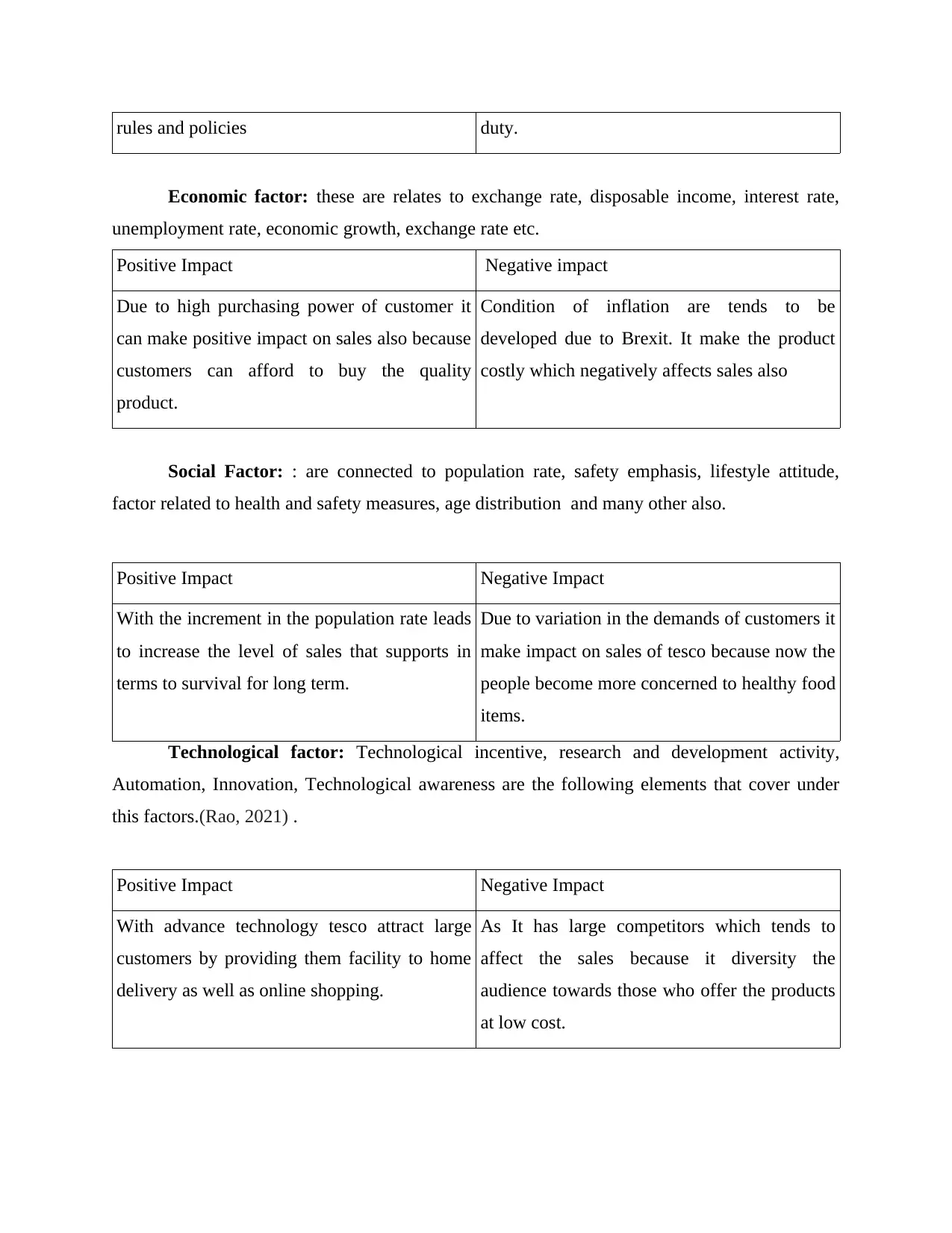
rules and policies duty.
Economic factor: these are relates to exchange rate, disposable income, interest rate,
unemployment rate, economic growth, exchange rate etc.
Positive Impact Negative impact
Due to high purchasing power of customer it
can make positive impact on sales also because
customers can afford to buy the quality
product.
Condition of inflation are tends to be
developed due to Brexit. It make the product
costly which negatively affects sales also
Social Factor: : are connected to population rate, safety emphasis, lifestyle attitude,
factor related to health and safety measures, age distribution and many other also.
Positive Impact Negative Impact
With the increment in the population rate leads
to increase the level of sales that supports in
terms to survival for long term.
Due to variation in the demands of customers it
make impact on sales of tesco because now the
people become more concerned to healthy food
items.
Technological factor: Technological incentive, research and development activity,
Automation, Innovation, Technological awareness are the following elements that cover under
this factors.(Rao, 2021) .
Positive Impact Negative Impact
With advance technology tesco attract large
customers by providing them facility to home
delivery as well as online shopping.
As It has large competitors which tends to
affect the sales because it diversity the
audience towards those who offer the products
at low cost.
Economic factor: these are relates to exchange rate, disposable income, interest rate,
unemployment rate, economic growth, exchange rate etc.
Positive Impact Negative impact
Due to high purchasing power of customer it
can make positive impact on sales also because
customers can afford to buy the quality
product.
Condition of inflation are tends to be
developed due to Brexit. It make the product
costly which negatively affects sales also
Social Factor: : are connected to population rate, safety emphasis, lifestyle attitude,
factor related to health and safety measures, age distribution and many other also.
Positive Impact Negative Impact
With the increment in the population rate leads
to increase the level of sales that supports in
terms to survival for long term.
Due to variation in the demands of customers it
make impact on sales of tesco because now the
people become more concerned to healthy food
items.
Technological factor: Technological incentive, research and development activity,
Automation, Innovation, Technological awareness are the following elements that cover under
this factors.(Rao, 2021) .
Positive Impact Negative Impact
With advance technology tesco attract large
customers by providing them facility to home
delivery as well as online shopping.
As It has large competitors which tends to
affect the sales because it diversity the
audience towards those who offer the products
at low cost.
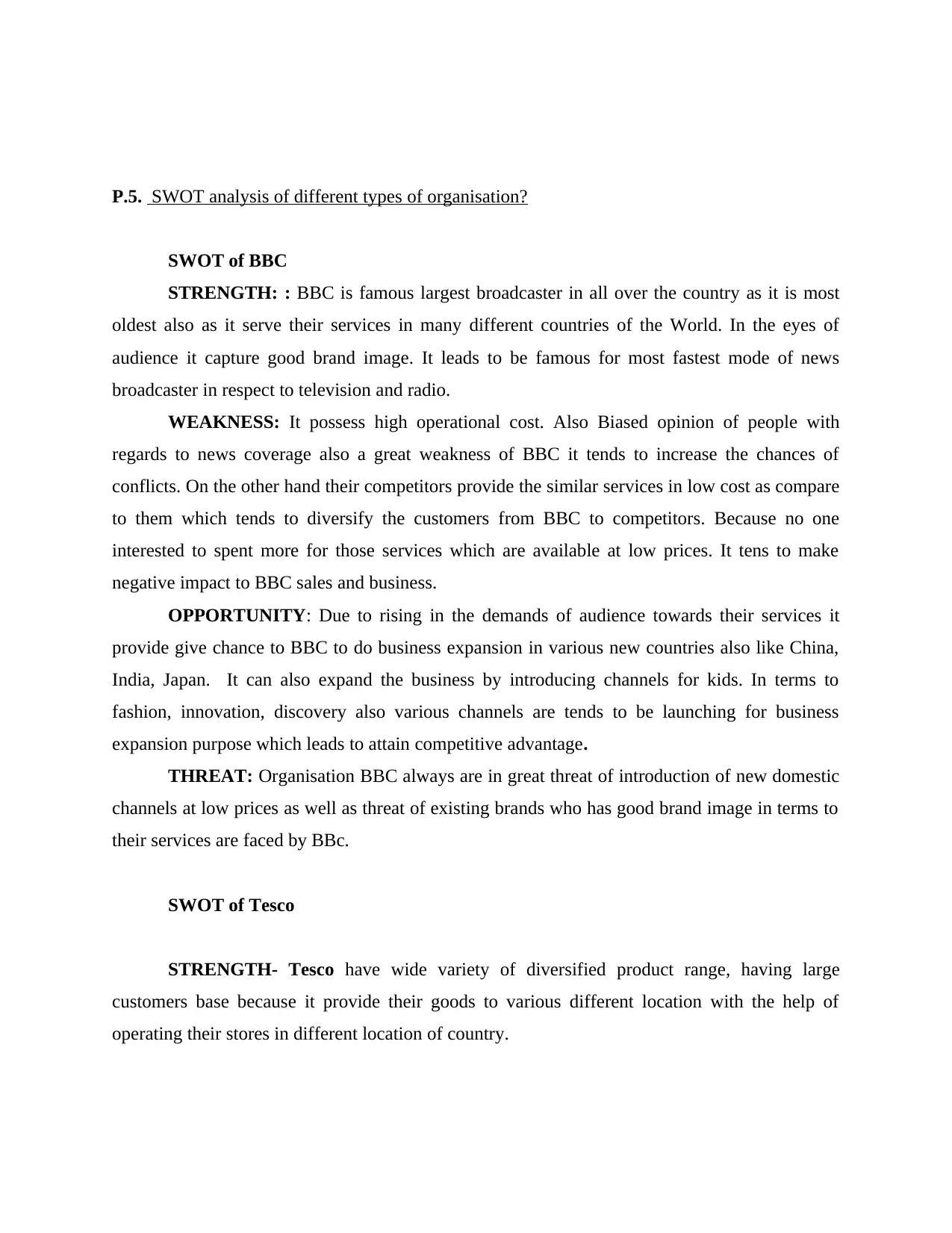
P.5. SWOT analysis of different types of organisation?
SWOT of BBC
STRENGTH: : BBC is famous largest broadcaster in all over the country as it is most
oldest also as it serve their services in many different countries of the World. In the eyes of
audience it capture good brand image. It leads to be famous for most fastest mode of news
broadcaster in respect to television and radio.
WEAKNESS: It possess high operational cost. Also Biased opinion of people with
regards to news coverage also a great weakness of BBC it tends to increase the chances of
conflicts. On the other hand their competitors provide the similar services in low cost as compare
to them which tends to diversify the customers from BBC to competitors. Because no one
interested to spent more for those services which are available at low prices. It tens to make
negative impact to BBC sales and business.
OPPORTUNITY: Due to rising in the demands of audience towards their services it
provide give chance to BBC to do business expansion in various new countries also like China,
India, Japan. It can also expand the business by introducing channels for kids. In terms to
fashion, innovation, discovery also various channels are tends to be launching for business
expansion purpose which leads to attain competitive advantage.
THREAT: Organisation BBC always are in great threat of introduction of new domestic
channels at low prices as well as threat of existing brands who has good brand image in terms to
their services are faced by BBc.
SWOT of Tesco
STRENGTH- Tesco have wide variety of diversified product range, having large
customers base because it provide their goods to various different location with the help of
operating their stores in different location of country.
SWOT of BBC
STRENGTH: : BBC is famous largest broadcaster in all over the country as it is most
oldest also as it serve their services in many different countries of the World. In the eyes of
audience it capture good brand image. It leads to be famous for most fastest mode of news
broadcaster in respect to television and radio.
WEAKNESS: It possess high operational cost. Also Biased opinion of people with
regards to news coverage also a great weakness of BBC it tends to increase the chances of
conflicts. On the other hand their competitors provide the similar services in low cost as compare
to them which tends to diversify the customers from BBC to competitors. Because no one
interested to spent more for those services which are available at low prices. It tens to make
negative impact to BBC sales and business.
OPPORTUNITY: Due to rising in the demands of audience towards their services it
provide give chance to BBC to do business expansion in various new countries also like China,
India, Japan. It can also expand the business by introducing channels for kids. In terms to
fashion, innovation, discovery also various channels are tends to be launching for business
expansion purpose which leads to attain competitive advantage.
THREAT: Organisation BBC always are in great threat of introduction of new domestic
channels at low prices as well as threat of existing brands who has good brand image in terms to
their services are faced by BBc.
SWOT of Tesco
STRENGTH- Tesco have wide variety of diversified product range, having large
customers base because it provide their goods to various different location with the help of
operating their stores in different location of country.
⊘ This is a preview!⊘
Do you want full access?
Subscribe today to unlock all pages.

Trusted by 1+ million students worldwide
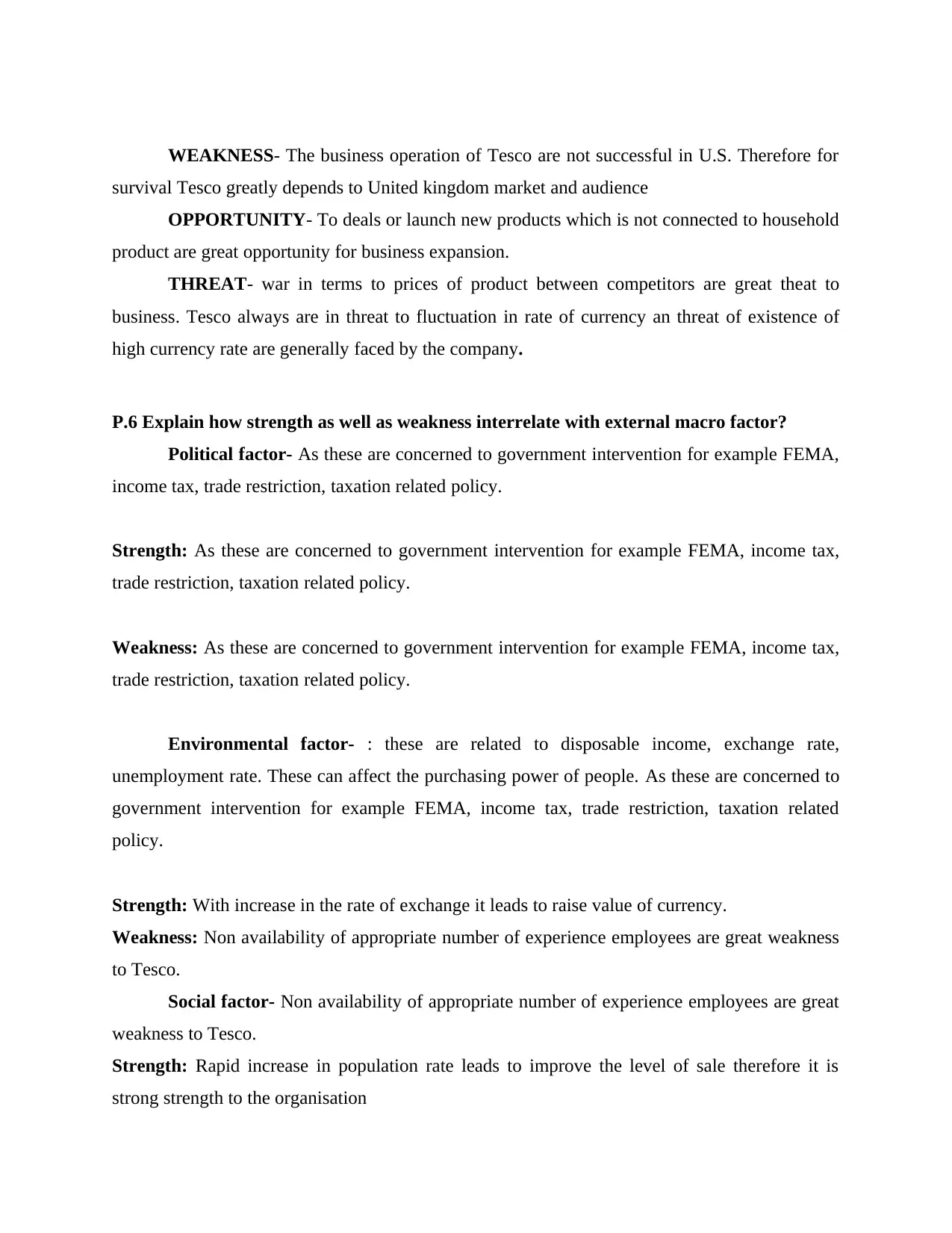
WEAKNESS- The business operation of Tesco are not successful in U.S. Therefore for
survival Tesco greatly depends to United kingdom market and audience
OPPORTUNITY- To deals or launch new products which is not connected to household
product are great opportunity for business expansion.
THREAT- war in terms to prices of product between competitors are great theat to
business. Tesco always are in threat to fluctuation in rate of currency an threat of existence of
high currency rate are generally faced by the company.
P.6 Explain how strength as well as weakness interrelate with external macro factor?
Political factor- As these are concerned to government intervention for example FEMA,
income tax, trade restriction, taxation related policy.
Strength: As these are concerned to government intervention for example FEMA, income tax,
trade restriction, taxation related policy.
Weakness: As these are concerned to government intervention for example FEMA, income tax,
trade restriction, taxation related policy.
Environmental factor- : these are related to disposable income, exchange rate,
unemployment rate. These can affect the purchasing power of people. As these are concerned to
government intervention for example FEMA, income tax, trade restriction, taxation related
policy.
Strength: With increase in the rate of exchange it leads to raise value of currency.
Weakness: Non availability of appropriate number of experience employees are great weakness
to Tesco.
Social factor- Non availability of appropriate number of experience employees are great
weakness to Tesco.
Strength: Rapid increase in population rate leads to improve the level of sale therefore it is
strong strength to the organisation
survival Tesco greatly depends to United kingdom market and audience
OPPORTUNITY- To deals or launch new products which is not connected to household
product are great opportunity for business expansion.
THREAT- war in terms to prices of product between competitors are great theat to
business. Tesco always are in threat to fluctuation in rate of currency an threat of existence of
high currency rate are generally faced by the company.
P.6 Explain how strength as well as weakness interrelate with external macro factor?
Political factor- As these are concerned to government intervention for example FEMA,
income tax, trade restriction, taxation related policy.
Strength: As these are concerned to government intervention for example FEMA, income tax,
trade restriction, taxation related policy.
Weakness: As these are concerned to government intervention for example FEMA, income tax,
trade restriction, taxation related policy.
Environmental factor- : these are related to disposable income, exchange rate,
unemployment rate. These can affect the purchasing power of people. As these are concerned to
government intervention for example FEMA, income tax, trade restriction, taxation related
policy.
Strength: With increase in the rate of exchange it leads to raise value of currency.
Weakness: Non availability of appropriate number of experience employees are great weakness
to Tesco.
Social factor- Non availability of appropriate number of experience employees are great
weakness to Tesco.
Strength: Rapid increase in population rate leads to improve the level of sale therefore it is
strong strength to the organisation
Paraphrase This Document
Need a fresh take? Get an instant paraphrase of this document with our AI Paraphraser
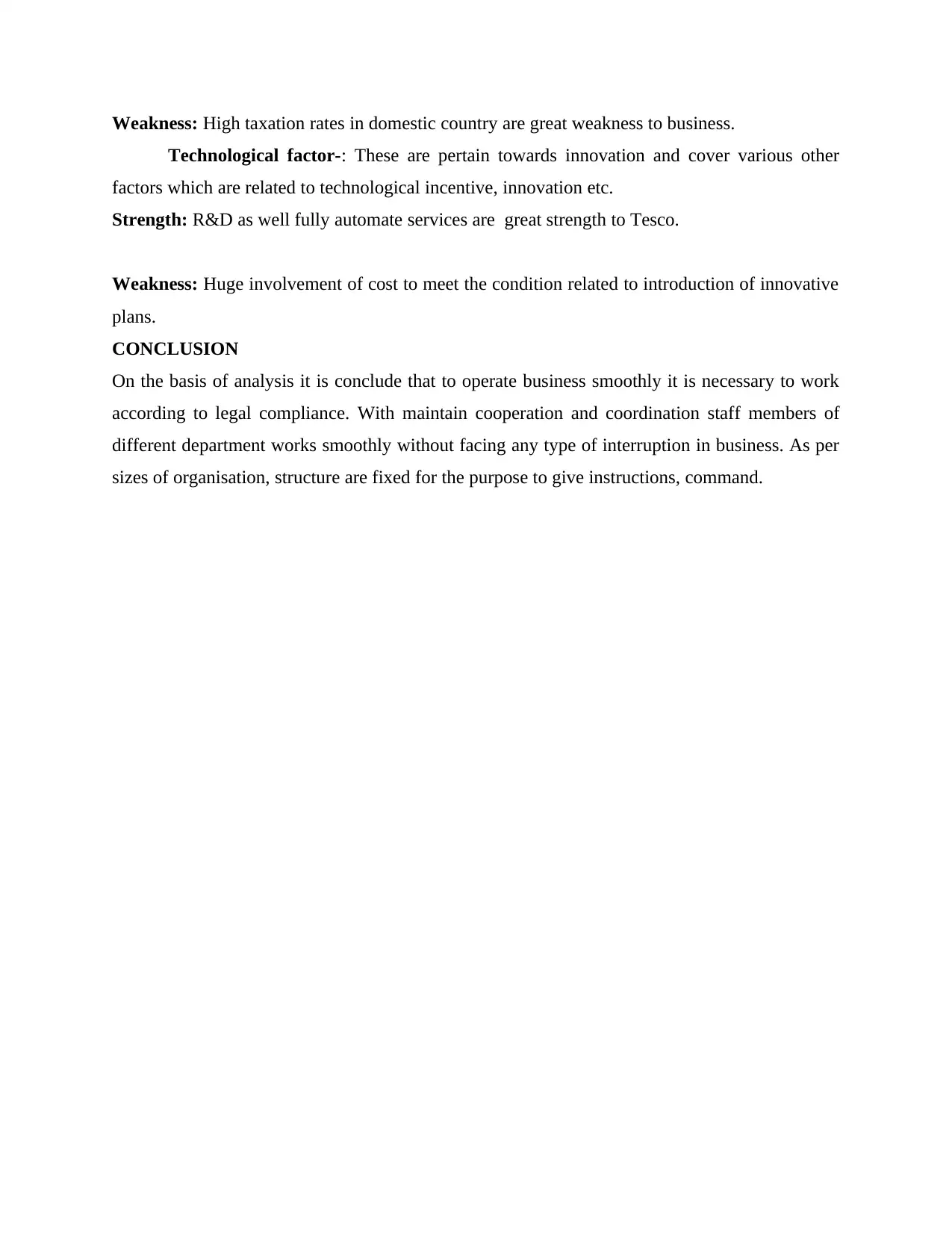
Weakness: High taxation rates in domestic country are great weakness to business.
Technological factor-: These are pertain towards innovation and cover various other
factors which are related to technological incentive, innovation etc.
Strength: R&D as well fully automate services are great strength to Tesco.
Weakness: Huge involvement of cost to meet the condition related to introduction of innovative
plans.
CONCLUSION
On the basis of analysis it is conclude that to operate business smoothly it is necessary to work
according to legal compliance. With maintain cooperation and coordination staff members of
different department works smoothly without facing any type of interruption in business. As per
sizes of organisation, structure are fixed for the purpose to give instructions, command.
Technological factor-: These are pertain towards innovation and cover various other
factors which are related to technological incentive, innovation etc.
Strength: R&D as well fully automate services are great strength to Tesco.
Weakness: Huge involvement of cost to meet the condition related to introduction of innovative
plans.
CONCLUSION
On the basis of analysis it is conclude that to operate business smoothly it is necessary to work
according to legal compliance. With maintain cooperation and coordination staff members of
different department works smoothly without facing any type of interruption in business. As per
sizes of organisation, structure are fixed for the purpose to give instructions, command.
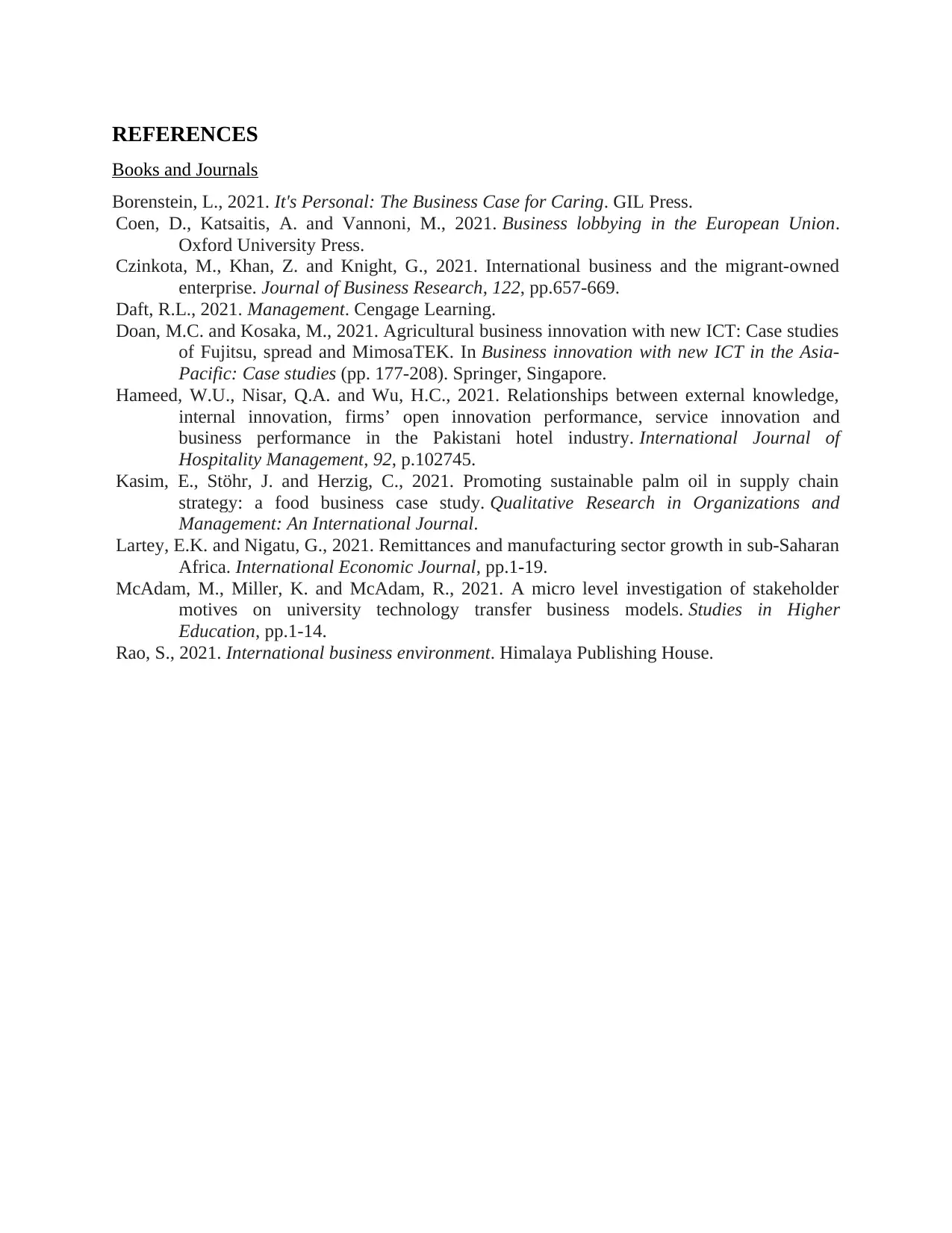
REFERENCES
Books and Journals
Borenstein, L., 2021. It's Personal: The Business Case for Caring. GIL Press.
Coen, D., Katsaitis, A. and Vannoni, M., 2021. Business lobbying in the European Union.
Oxford University Press.
Czinkota, M., Khan, Z. and Knight, G., 2021. International business and the migrant-owned
enterprise. Journal of Business Research, 122, pp.657-669.
Daft, R.L., 2021. Management. Cengage Learning.
Doan, M.C. and Kosaka, M., 2021. Agricultural business innovation with new ICT: Case studies
of Fujitsu, spread and MimosaTEK. In Business innovation with new ICT in the Asia-
Pacific: Case studies (pp. 177-208). Springer, Singapore.
Hameed, W.U., Nisar, Q.A. and Wu, H.C., 2021. Relationships between external knowledge,
internal innovation, firms’ open innovation performance, service innovation and
business performance in the Pakistani hotel industry. International Journal of
Hospitality Management, 92, p.102745.
Kasim, E., Stöhr, J. and Herzig, C., 2021. Promoting sustainable palm oil in supply chain
strategy: a food business case study. Qualitative Research in Organizations and
Management: An International Journal.
Lartey, E.K. and Nigatu, G., 2021. Remittances and manufacturing sector growth in sub-Saharan
Africa. International Economic Journal, pp.1-19.
McAdam, M., Miller, K. and McAdam, R., 2021. A micro level investigation of stakeholder
motives on university technology transfer business models. Studies in Higher
Education, pp.1-14.
Rao, S., 2021. International business environment. Himalaya Publishing House.
Books and Journals
Borenstein, L., 2021. It's Personal: The Business Case for Caring. GIL Press.
Coen, D., Katsaitis, A. and Vannoni, M., 2021. Business lobbying in the European Union.
Oxford University Press.
Czinkota, M., Khan, Z. and Knight, G., 2021. International business and the migrant-owned
enterprise. Journal of Business Research, 122, pp.657-669.
Daft, R.L., 2021. Management. Cengage Learning.
Doan, M.C. and Kosaka, M., 2021. Agricultural business innovation with new ICT: Case studies
of Fujitsu, spread and MimosaTEK. In Business innovation with new ICT in the Asia-
Pacific: Case studies (pp. 177-208). Springer, Singapore.
Hameed, W.U., Nisar, Q.A. and Wu, H.C., 2021. Relationships between external knowledge,
internal innovation, firms’ open innovation performance, service innovation and
business performance in the Pakistani hotel industry. International Journal of
Hospitality Management, 92, p.102745.
Kasim, E., Stöhr, J. and Herzig, C., 2021. Promoting sustainable palm oil in supply chain
strategy: a food business case study. Qualitative Research in Organizations and
Management: An International Journal.
Lartey, E.K. and Nigatu, G., 2021. Remittances and manufacturing sector growth in sub-Saharan
Africa. International Economic Journal, pp.1-19.
McAdam, M., Miller, K. and McAdam, R., 2021. A micro level investigation of stakeholder
motives on university technology transfer business models. Studies in Higher
Education, pp.1-14.
Rao, S., 2021. International business environment. Himalaya Publishing House.
⊘ This is a preview!⊘
Do you want full access?
Subscribe today to unlock all pages.

Trusted by 1+ million students worldwide
1 out of 13
Related Documents
Your All-in-One AI-Powered Toolkit for Academic Success.
+13062052269
info@desklib.com
Available 24*7 on WhatsApp / Email
![[object Object]](/_next/static/media/star-bottom.7253800d.svg)
Unlock your academic potential
Copyright © 2020–2025 A2Z Services. All Rights Reserved. Developed and managed by ZUCOL.





